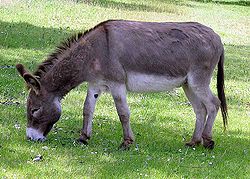 Donkeys vary considerably in size, depending on breed and management. Most domestic donkeys range from 0.9 m (2' 11") to over 1.4 m (4' 7") tall, though the Mammoth Jack breed is taller, and the Andalucian-Cordobesan breed of southern Spain can reach up to 1.6 m (5' 2") high.
Donkeys vary considerably in size, depending on breed and management. Most domestic donkeys range from 0.9 m (2' 11") to over 1.4 m (4' 7") tall, though the Mammoth Jack breed is taller, and the Andalucian-Cordobesan breed of southern Spain can reach up to 1.6 m (5' 2") high.
Donkeys are adapted to marginal desert lands, and have many traits that are unique to the species as a result. Wild donkeys live separated from each other, unlike tight wild horse and feral horse herds. Donkeys have developed very loud vocalizations, which help keep in contact with other donkeys over the wide spaces of the desert. The best-known call is referred to as a "bray," which can be heard for over three kilometers. Donkeys have larger ears than horses. Their longer ears may pick up more distant sounds, and may help cool the donkey's blood. Donkeys in the wild can defend themselves with a powerful kick of their hind legs as well as by biting and striking with their front hooves.
Donkeys' tough digestive system is somewhat less prone to colic than that of horses, can break down near-inedible vegetation and extract moisture from food very efficiently. As a rule, donkeys need smaller amounts of feed than horses of comparable height and weight. Because they are easy keepers, if overfed, donkeys are also quite susceptible to developing a condition called laminitis.
Braying is the characteristic sound made by an ass, donkey, and most mules. Donkeys use this sound to communicate and will bray more frequently when a new donkey is encountered. The sound typically lasts for twenty seconds.The sound may be rendered onomatapoeically as "eeyore" and so this was used as the name of the donkey in Winnie-the-Pooh. Donkeys may be trained to bray or not to bray upon command. This may be used as a form of mockery. Braying may be considered a simile for loud and foolish speech.
Donkeys have a lifespan of 30 to 50 years.
